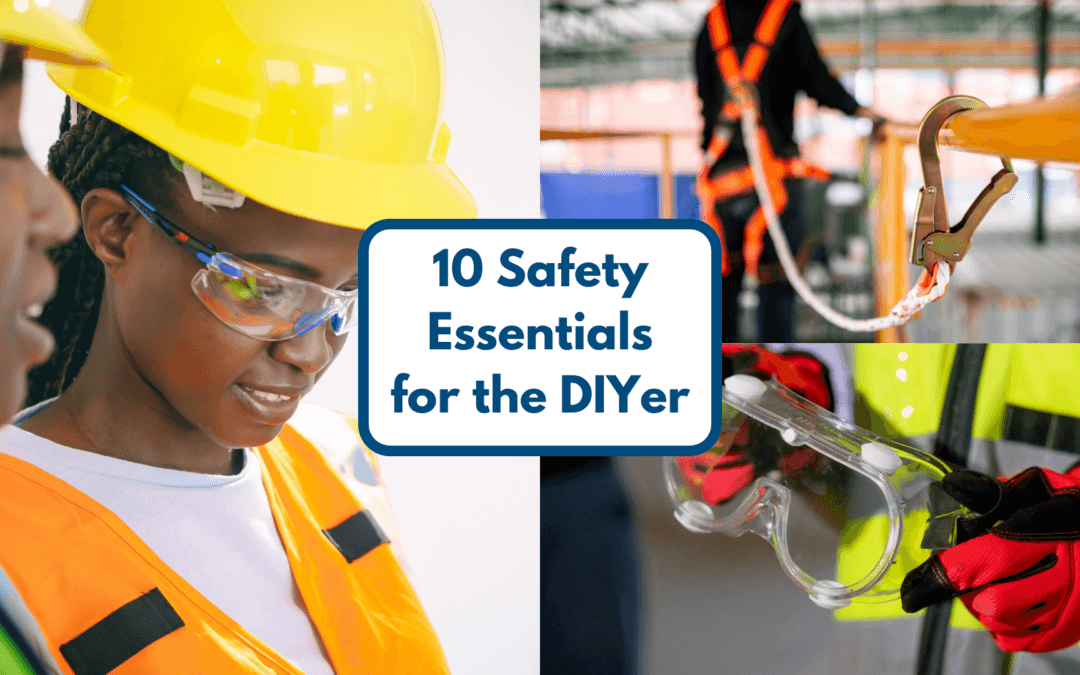Taking on DIY projects can be both exciting and rewarding, but safety should always come first. Whether you’re assembling furniture, building shelves, or tackling a more advanced home renovation, having the right safety tools and gear is essential to protect yourself from accidents.
This guide highlights the must-have safety essentials for DIYers and explains how they can keep you safe while working on projects. Be sure to check out our dedicated Safety Tools Spotlight Pages for more detailed information and recommendations.
Why Safety Matters in DIY Projects
Even seemingly simple tasks like drilling or sanding can pose risks, such as flying debris, sharp edges, or harmful dust. By investing in proper safety gear, you can minimize these hazards and complete your projects with confidence and peace of mind.
1. Safety Glasses and Goggles
- Purpose: Protect your eyes from flying debris, dust, and splinters during tasks like cutting, drilling, or sanding.
- Key Features:
- Impact-resistant lenses.
- Anti-fog and scratch-resistant coatings for visibility.
- Full-seal goggles for protection against fine dust and chemical splashes.
Spotlight Tool: Check out our detailed guide on Safety Glasses to find the best options for your projects.
2. Gloves for Hand Protection
- Purpose: Prevent cuts, abrasions, and burns while handling sharp tools, hot surfaces, or rough materials.
- Types of Gloves:
- Cut-Resistant Gloves: Ideal for woodworking or using power tools.
- Heat-Resistant Gloves: Essential for welding or working with hot materials.
- General-Purpose Work Gloves: Great for handling rough materials like wood or metal.
Tip: Always choose gloves that fit snugly for better grip and control.
3. Dust Mask or Respirator
- Purpose: Protect your lungs from dust, fumes, and harmful particles generated by tasks like sanding, painting, or cutting drywall.
- Types of Masks:
- Dust Masks: For basic protection against non-toxic dust.
- Respirators with Filters: Necessary for working with chemicals or fine particles like silica dust.
Pro Tip: Choose N95-rated masks for better protection during high-dust tasks.
4. Hearing Protection
- Purpose: Safeguard your ears from loud noises produced by power tools like saws, drills, or sanders.
- Options:
- Earplugs: Compact and affordable, suitable for occasional use.
- Earmuffs: Provide better noise reduction for prolonged exposure.
Why It Matters: Prolonged exposure to noise levels above 85 decibels can cause permanent hearing damage.
5. Steel-Toe Boots or Sturdy Footwear
- Purpose: Protect your feet from falling objects, sharp debris, and accidental impacts.
- Key Features:
- Reinforced steel or composite toe caps.
- Slip-resistant soles for stability on various surfaces.
DIY Tip: Always ensure your footwear provides adequate ankle support, especially for outdoor projects or uneven surfaces.
6. Hard Hat
- Purpose: Prevent head injuries caused by falling objects or accidental bumps in tight spaces.
- Features to Look For:
- Lightweight yet durable materials.
- Adjustable fit for comfort.
- Compliance with safety standards like ANSI Z89.1.
Hard hats are particularly important for larger projects like installing fixtures or working on roofs.
7. Knee Pads
- Purpose: Provide cushioning and support for tasks that require kneeling, such as installing flooring or gardening.
- Key Features:
- Thick foam padding for comfort.
- Adjustable straps to keep them securely in place.
Extra Tip: Use gel-cushioned knee pads for extended tasks to prevent joint strain.
8. First Aid Kit
- Purpose: Quickly address minor injuries like cuts, burns, or splinters during a project.
- Essential Contents:
- Adhesive bandages.
- Antiseptic wipes.
- Burn ointment.
- Tweezers for removing splinters.
Keep the kit easily accessible in your workspace for emergencies.
9. Fire Extinguisher
- Purpose: Handle accidental fires caused by tools, wiring, or flammable materials.
- Type: Choose a multipurpose (Class ABC) extinguisher suitable for home workshops.
DIY Safety Tip: Learn how to use your fire extinguisher and ensure it’s inspected regularly.
10. Tool-Specific Safety Gear
Certain tools require additional safety precautions:
- Welding Mask: Protects your face and eyes during welding projects.
- Angle Grinder Guard: Prevents injuries caused by sparks and flying debris.
- Chainsaw Safety Gear: Includes protective chaps and face shields.
Explore our tool-specific safety pages for more insights on the best gear for your tools.
Safety Tips for DIY Projects
- Plan Ahead: Assess potential risks before starting your project and gather the appropriate safety gear.
- Stay Organized: Keep your workspace tidy to reduce tripping hazards and accidental injuries.
- Follow Instructions: Always read the user manuals for tools and follow safety guidelines.
- Take Breaks: Fatigue can lead to mistakes. Rest when needed to stay focused and safe.
Conclusion
Safety is the foundation of every successful DIY project. By equipping yourself with the right safety tools and gear, you can tackle home improvement tasks with confidence while minimizing risks. For detailed recommendations on safety tools, visit our Safety Tools Spotlight Pages to find the perfect gear for your needs.
For more tips on getting started with tools and trades, check out the Breaking Barriers Book to explore how you can safely and effectively dive into hands-on work while building your skills.
